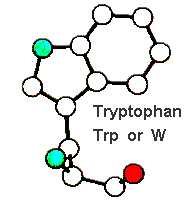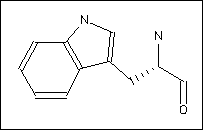

For an updated version of these pages, click here


Substitution preferences:
All protein types:
| Favoured | Tyr ( 2) | Phe ( 1) | ||||||
| Disfavoured | Met (-1) | Leu (-2) | Gln (-2) | Cys (-2) | Thr (-2) | Gly (-2) | His (-2) | Ala (-3) |
| Lys (-3) | Ile (-3) | Glu (-3) | Arg (-3) | Ser (-3) | Val (-3) | Asp (-4) | Asn (-4) | |
| Pro (-4) |
| Favoured | Tyr ( 2) | Phe ( 1) | ||||||
| Neutral | His ( 0) | Met ( 0) | Leu ( 0) | |||||
| Disfavoured | Arg (-1) | Cys (-1) | Val (-1) | Lys (-1) | Ile (-1) | Gly (-2) | Asn (-2) | Gln (-2) |
| Pro (-2) | Ser (-2) | Thr (-2) | Ala (-2) | Asp (-2) | Glu (-2) |
| Favoured | Phe ( 1) | Tyr ( 1) | ||||||
| Disfavoured | Arg (-1) | Gln (-1) | Glu (-1) | Met (-1) | His (-1) | Thr (-1) | Val (-1) | Ile (-1) |
| Ser (-1) | Ala (-2) | Gly (-2) | Lys (-2) | Leu (-2) | Asn (-3) | Asp (-3) | Pro (-3) | |
| Cys (-5) |
| Favoured | Arg ( 5) | Lys ( 3) | Cys ( 1) | |||||
| Neutral | Gln ( 0) | |||||||
| Disfavoured | His (-1) | Val (-2) | Gly (-2) | Leu (-2) | Met (-2) | Phe (-3) | Asn (-3) | Tyr (-3) |
| Ile (-3) | Ala (-3) | Ser (-3) | Glu (-3) | Asp (-4) | Thr (-4) | Pro (-6) |
Role in structure: Being hydrophobic, Tryptophan prefers to be buried in protein hydrophobic cores. The aromatic side chain can also mean that Tryptophan is involved in stacking interactions with other aromatic side-chains.
Role in function: As it contains a non-carbon atom (nitrogen) in the aromatic ring system, Tryptophan is more reactive than Phenylalanine though it is less reactive than Tyrosine. The Tryptophan nitrogens can play a role in binding to non-protein atoms, but such instances are rare.
Like other aromatic amino acids, Tryptophan can be involved in interactions with non-protein ligands that themselves contain aromatic groups via stacking interactions. Tryptophan and other aromatic amino acids can be involved in binding to poly-proline containing peptides, for example, in SH3 or WW domains.